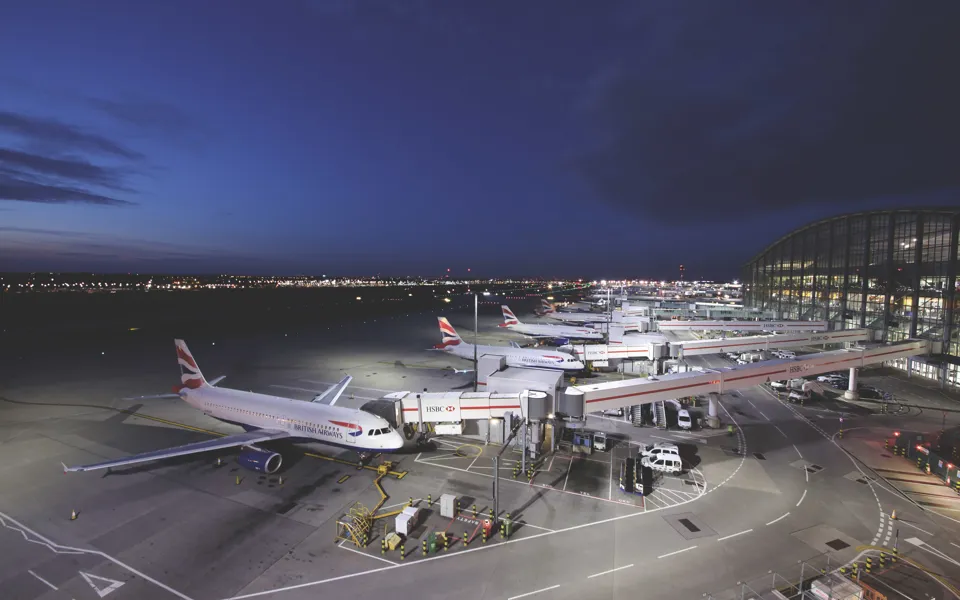
Greener fuels, greener skies
09 Mar 2023
Demand for air travel continues to grow faster than other transport modes, creating a decarbonisation conundrum. Rui Neiva and Gareth Horton address some of the big questions and identify potential solutions for the aviation sector.
The European Green Deal is the European Union’s (EU’s) long-term growth strategy to make the continent climate neutral by 2050. To reach this target Europe must reduce its net greenhouse gas emissions by at least 55 per cent by 2030 compared to 1990 levels, and in 2021 adopted ‘Fit for 55’ – a legislative package to deliver the European Green Deal.
In December 2022, the European Commission reached an agreement with the European Parliament and Council to help make the aviation sector ‘Fit for 55’, setting in law its contribution to the target. Ricardo provided the European Parliament with expertise across the aviation value chain, from policy to strategy to technology innovation and implementation.
What’s next? To answer this and other questions, we spoke to Rui and Gareth.
What’s the decarbonisation challenge for aviation?
Aviation emissions in Europe increased by an average of five per cent year-on-year between 2013 and 2019. Even though aviation emissions fell dramatically during the pandemic, they are still projected to grow further. To achieve climate neutrality, the EU needs to reduce transport emissions, including aviation, by 90 per cent by 2050 compared to 1990 levels.
Currently aviation represents only a small part of overall transport emissions. However, demand for air travel is still growing faster than other transport modes. While electrification is already a proven technology for decarbonisation in the rail or passenger car sectors, it’s far less applicable for the aviation sector because of energy needs, the density of batteries and the sheer distances that aircraft travel.
The aviation sector could face potential reputational damage if it increases its share of total emissions as it is the slowest to decarbonise. And if the industry fails to make progress in reducing its emissions intensity, regulators may feel obliged to take action by curbing demand for air travel.
What’s needed is urgent action to transition to low-carbon solutions, taking into account the long timeframe to develop the technologies, roll out infrastructure and replace fleets.
What progress is being made by the industry and governments?
The aviation industry and governments already have initiatives in place but they will need to continue taking action and, in some cases, ramp up efforts. Here are four key areas:
- Sustainable aviation fuel: drop-in replacement fuel is one of the most significant for decarbonising aircraft. Options include biofuels, advanced biofuels (made from sustainable feedstocks, preferably waste) and electrofuels/synthetic fuels. Drop-in fuels are favoured as a technology solution because of the need for high energy density and the realistic timeframes for implementation. They have the same characteristics as conventional aviation fuel – kerosene – but on a net life cycle basis they have the potential to reduce significantly the level of emissions.Sustainable aviation fuels have become increasingly available in the last five years, helped by investment from companies and governments. For example, the UK Government has committed £165 million in taking sustainable aviation fuel capability to production level through the Advanced Fuels Fund programme, which Ricardo manages. Commercial-scale development is moving forward at pace; this is really the key for decarbonising most long-distance flights in the future.
- Better aviation engine performance and efficiency: aircraft continue to evolve in their engine efficiency and performance – a plane today, transporting the same number of people the same distance, burns around 70 per cent less fuel than it would have done using 1960s jet aircraft technology.
Technologies that have been researched during the last two decades may also help to produce a step change of a 15-25 per cent reduction in emissions if applied to the next generation of aircraft engines. - ‘Green propulsion’: in the longer term, completely different energy sources such as battery electric or hydrogen could be key for decarbonising smaller aircraft performing short- or medium-haul flights. For a flight from Southampton to Edinburgh, for example, it’s possible that by 2040 a battery electric aircraft will be in use. For medium-haul journeys, such as flights within the EU or the US, we could see aircraft becoming hydrogen fuelled in that same period – although this will require a massive investment in green electricity to deliver the full environmental benefits.
- Decarbonising airports: aircraft are not the only aspect of aviation needing to decarbonise. Major airports have very ambitious net zero goals and are increasingly taking a holistic view of their carbon emissions. This means analysing emissions from aircraft ground operations; the thousands of different vehicles and machines, from refuelling trucks to baggage trucks to aircraft ‘tugs’; clean energy supply for the airport; even looking at the transport options used by employees, suppliers and passengers for their journeys to the airport and increasing modal share towards trains and buses.
Measures bring costs, of course, so balanced trade-offs may be needed to avoid further damage to an industry that has been on something of a roller-coaster with the pandemic.
What’s the future looking like?
We have four predictions:
- For the European Green Deal to work, even the more advanced aircraft technologies alone will not be enough. Airlines will need to use sustainable aviation fuels at scale to meet Green Deal requirements in the next ten years. Investment in sustainable aviation fuel production and distribution will need to increase considerably.
- Besides fuel producers and airlines, other major industry players will have a role to play in decarbonising aviation by 2050. Hydrogen and electric aircraft will be in use on a number of shorter routes and longer-range, zero-emission aircraft will be gradually introduced.
- Renewable energy will be critical to support the transition; delivering synthetic fuels or hydrogen fuel will require massive investment in clean electricity generation so that these fuels are actually green.
- In a decade’s time a majority of landside vehicles at large airports will be electrified. In 20 years virtually all of them will be, even in smaller airports.
Ricardo is helping to drive progress throughout the aviation industry
Policy expertise gained from advising the European Commission (EC) and governments around the world means Ricardo is uniquely placed to advise on regulation relating to climate change. As part of the guidance provided to the European Parliament, Ricardo experts produced a roadmap for achieving aviation Green Deal objectives by 2050 which projected the introduction and deployment of potential aircraft technologies and emission savings.*
Ricardo studies supported most of the aviation-related policies proposed by the EC in the ‘Fit for 55’ package, including a study of taxation options for the fuel used on flights within the EU, and another assessing possible ways to implement a mandate for a minimum percentage of sustainable aviation fuel to be used in all EU airports.
The company also supports the EU Aviation Safety Agency in activities carried out by the International Civil Aviation Organisation’s working groups that assess potential changes in aircraft certification regulations.
Ricardo is also supporting the wider aviation sector, including government bodies and funding institutions around the world, as they seek to accelerate the production and use of sustainable aviation fuels, considering the full range of feedstocks and production processes to maximise the near-term potential for emissions reductions from the use of these advanced fuel options.
Creating net zero airports
On the airport side, a recent report with the Energy Institute showed, using life cycle assessment (LCA) analysis, how adopting different technologies to refuel aircraft could cut greenhouse gas emissions.
Ricardo is supporting major UK airports with their net zero strategies, including emissions inventory calculations; carbon action planning; emission reduction strategies; fleet management such as replacing or retrofitting airport vehicles; and adopting more sustainable modes of transport.
The company’s knowledge of aviation policy, road vehicle technologies and overall LCA is becoming ever more important due to recognition that emissions aren’t only generated during use, but also during other life cycle stages such as production and disposal. This is no less important than the improvements promised by sustainable aviation fuels.
Rui Neiva is Ricardo’s Principal Consultant, Sustainable Transport, and Gareth Horton is Principal Consultant, Aviation
*Please note that in relation to this study, all views expressed here are Ricardo’s not the European Parliament’s.
If you have any questions or want to know more about the topics mentioned above, get in touch.




 Follow Ricardo plc for regular updates
Follow Ricardo plc for regular updates




